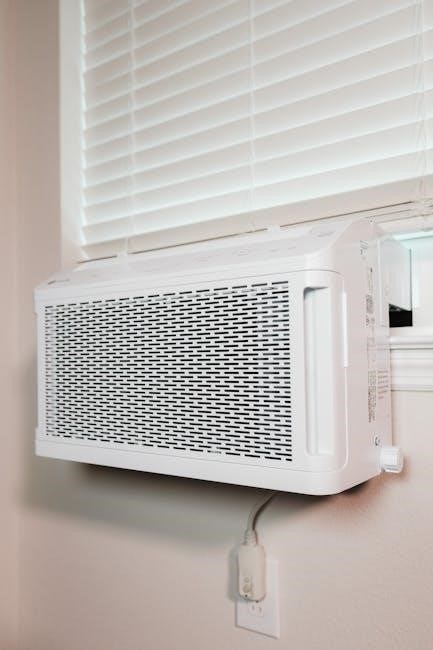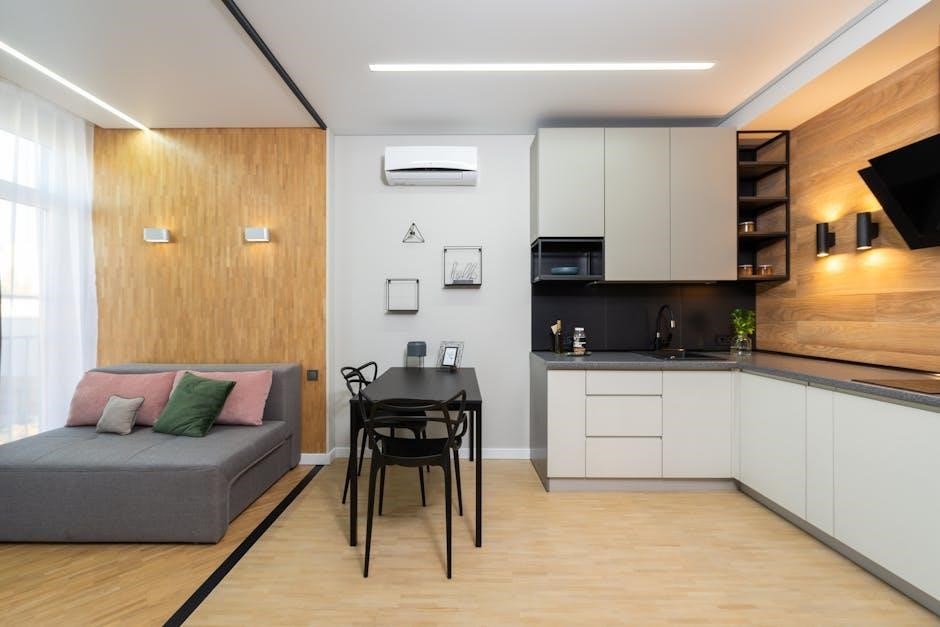Understanding your Toshiba window air conditioner requires the correct manual for optimal performance and safety. These guides detail installation, operation, and maintenance procedures.
Accessing these resources ensures efficient cooling, heating, and smart WiFi feature utilization, maximizing your comfort and energy savings throughout the season.
Importance of the Manual
The Toshiba window air conditioner manual is absolutely crucial for several reasons, extending beyond simply turning the unit on and off. It provides detailed, step-by-step instructions for proper installation, ensuring a secure fit within your window frame – particularly important given the adjustable slider length of 26-1/2 to 52 inches.
Furthermore, the manual outlines essential safety precautions, covering electrical safety and proper ventilation, safeguarding against potential hazards. It also details how to effectively utilize the smart WiFi features, connecting to your home network and controlling the unit via the mobile app.
Finally, understanding the maintenance schedule, like cleaning the air filter, will prolong the lifespan of your 6,000 or 8,000 BTU model and maintain optimal cooling efficiency. Ignoring the manual can lead to improper operation, reduced performance, and potential damage.
Where to Find Your Toshiba Air Conditioner Manual
Locating your Toshiba window air conditioner manual is straightforward. First, check the packaging that accompanied your unit; a physical copy is often included. If you’ve misplaced it, the Toshiba website is an excellent resource. Navigate to their support or downloads section and search using your specific model number, such as RAC-WK0612CRRU.
Alternatively, many retailers that sell Toshiba air conditioners, like those offering the 6,000 BTU Smart WiFi model, provide downloadable manuals on their websites. A general online search using terms like “Toshiba RAC-WK0612CRRU manual” will also yield results.
Consumer Reports also references testing documentation, though it isn’t a direct manual source. Remember, having the correct manual ensures proper installation and operation.

Understanding Your Toshiba Air Conditioner Model
Identifying your Toshiba air conditioner’s model is crucial for accessing the correct documentation and support. Knowing specifics, like the BTU rating (6,000 or 8,000), is key.
Locating the Model Number
Finding your Toshiba window air conditioner’s model number is the first step towards accessing specific manuals and support resources. Typically, this alphanumeric code – such as RAC-WK0612CRRU – is located on a sticker or label affixed to the unit itself.
Check the side or rear panels of the air conditioner, often near the control panel or the power cord connection. The label might also be found inside the unit, requiring a brief inspection. This number is vital for confirming compatibility with replacement parts, like window kits (for models PX0812CWRU, PX1011CWRU), and downloading the appropriate user guide.

Without the correct model number, finding accurate information can be challenging, so take a moment to locate it before proceeding.
Decoding the Model Number (e.g., RAC-WK0612CRRU)
Toshiba model numbers, like RAC-WK0612CRRU, contain valuable information about the air conditioner. While a complete breakdown isn’t publicly available, certain segments offer clues. “RAC” likely signifies Room Air Conditioner. The following numbers often indicate cooling capacity – “06” potentially representing 6,000 BTU, and “12” relating to a specific feature or series.
The letters following the numbers denote variations in features, color, or regional specifications. Understanding this structure helps identify key characteristics. Knowing the BTU rating (6,000 or 8,000) is crucial for determining cooling power. This information, combined with the model number, ensures you access the correct documentation and compatible accessories.
Ultimately, the model number is your key to unlocking specific product details.

Installation Guide
Proper installation is vital for efficient operation. Utilize the included window kit, ensuring a secure fit within windows sized 26-1/2 to 52 inches for optimal cooling.
Window Kit Installation (Including Slider Length — 26-1/2 to 52 inches)
Begin by carefully unpacking the window kit components, verifying all parts are present. The fully collapsed slider measures 26-1/2 inches, extending to approximately 52 inches to accommodate various window widths. Ensure the kit is specifically designed for your Toshiba AC model – PX0812CWRU or PX1011CWRU are confirmed compatible models.
Install the side panels securely within the window frame, adjusting the slider length to create a snug, yet manageable fit. Proper alignment is crucial to prevent air leakage and maintain cooling efficiency. Double-check compatibility; if your model isn’t listed, contact support for assistance in finding the correct kit.
Finally, secure the unit within the window, following the detailed instructions provided in your specific model’s manual for a safe and effective installation.
Proper Window Sealing Techniques
Achieving an airtight seal around your Toshiba window air conditioner is paramount for optimal performance and energy conservation. Utilize the provided foam insulation strips to fill any gaps between the window frame and the air conditioner chassis or window kit components.
Pay close attention to corners and edges, ensuring a continuous barrier against air infiltration. Consider using weather stripping or sealant for particularly stubborn gaps. A well-sealed unit prevents warm air from entering, reducing the strain on the cooling system.
Regularly inspect the seals for deterioration and replace any damaged insulation to maintain efficiency and prevent moisture buildup.

Operating Instructions
Toshiba air conditioners offer cooling, heating, and fan modes, easily controlled via the unit or remote. Enjoy three fan speeds for personalized comfort and control.
Powering On and Off
To initiate operation, ensure the unit is plugged into a grounded outlet. Press the power button located on the control panel or the remote control. A confirmation light will illuminate, indicating the air conditioner is active.
For shutdown, simply press the power button again. The unit will begin a brief shutdown sequence, and the confirmation light will extinguish. Always disconnect the power cord during extended periods of non-use or before performing any maintenance.
Note: Some models feature an auto-restart function, which will resume operation with the previous settings after a power outage. Refer to your specific model’s manual for details regarding this feature and any safety precautions.
Cooling, Heating, and Fan Modes
Toshiba window air conditioners offer versatile operation with cooling, heating, and fan-only modes. Select ‘Cool’ for reducing room temperature, adjusting the thermostat to your desired level. ‘Heat’ mode provides warmth during colder periods, utilizing the unit’s heating capabilities.
The ‘Fan’ mode circulates air without temperature adjustment, ideal for ventilation. Mode selection is typically achieved via buttons on the control panel or remote. Some models include an ‘Auto’ mode, automatically switching between cooling and heating to maintain a set temperature.
Remember to ensure windows and doors are properly sealed for optimal efficiency in cooling or heating modes.
Adjusting Fan Speed (3-Speed Options)
Toshiba window air conditioners commonly feature three fan speed settings: Low, Medium, and High. These settings control the airflow and cooling/heating intensity. ‘Low’ provides a gentle breeze, ideal for quiet operation and minimal energy consumption. ‘Medium’ offers a balanced airflow for general comfort.
‘High’ delivers maximum airflow for rapid cooling or heating. Fan speed adjustments are typically made using buttons on the unit’s control panel or via the remote control. Experiment with different speeds to find the optimal balance between comfort and energy efficiency.
Consider using lower speeds during off-peak hours or when less intense cooling/heating is needed.
Using the Remote Control
The Toshiba window air conditioner remote control offers convenient operation from a distance. It typically mirrors all functions available on the unit’s control panel, including power, mode selection (Cool, Heat, Fan), temperature adjustment, and fan speed control.
Ensure the remote has fresh batteries for optimal performance. Point the remote directly at the air conditioner’s sensor for reliable communication. Some models include smart WiFi connectivity, allowing control via a mobile app, supplementing the remote’s functionality.
Explore the remote’s features to customize your cooling or heating experience efficiently.

Smart WiFi Features
Toshiba Smart WiFi air conditioners enable remote control and monitoring via a mobile app, offering convenience and energy efficiency through smartphone connectivity.
Connecting to WiFi
To connect your Toshiba window air conditioner to WiFi, begin by downloading the Toshiba Smart Home app from your device’s app store. Ensure your home WiFi network is a 2.4 GHz connection, as 5 GHz networks are typically not supported. Open the app and create an account or log in if you already have one.
Follow the in-app instructions to add your air conditioner; the app will guide you through the process of entering your WiFi network name and password. The air conditioner needs to be in pairing mode, usually activated by pressing and holding a specific button on the unit or remote control. Once connected, you’ll receive a confirmation message within the app, allowing for remote control and access to smart features.
Using the Mobile App for Control
The Toshiba Smart Home mobile app provides comprehensive control over your window air conditioner from anywhere with an internet connection. Through the app, you can remotely power the unit on or off, adjust the cooling, heating, or fan modes, and precisely set your desired temperature.
Furthermore, the app allows you to customize fan speeds, utilize the 2-way air deflection feature, and create schedules for automated operation. You can monitor energy usage and receive notifications regarding filter maintenance or potential issues. The intuitive interface simplifies operation, offering a convenient and efficient way to manage your indoor climate.

Maintenance and Troubleshooting
Regular cleaning of the air filter and proper water drainage are crucial for optimal performance. Addressing common issues promptly ensures longevity and efficiency.
Cleaning the Air Filter
Maintaining a clean air filter is paramount for efficient operation and air quality. Regularly inspect the filter, ideally every two weeks during peak usage, and clean or replace it as needed. A clogged filter restricts airflow, reducing cooling performance and potentially damaging the unit.
To clean the filter, gently remove it from the air conditioner. Vacuum the filter to remove loose dust and debris. For a more thorough cleaning, wash the filter with mild soap and water, ensuring it is completely dry before reinstalling. Always turn off and unplug the air conditioner before accessing the filter. Replacing the filter annually, or more frequently in dusty environments, is recommended for optimal performance.
A clean filter contributes to energy savings and extends the lifespan of your Toshiba window air conditioner.
Draining Water
During operation, especially in cooling mode, your Toshiba window air conditioner accumulates condensation. Regularly draining this water prevents overflow and potential water damage. Most models feature a drain hole or removable drain plug at the rear of the unit.
To drain, carefully position a container beneath the drain outlet. Gently remove the plug or allow water to flow through the hole. Ensure the unit is tilted slightly towards the drain to facilitate complete emptying. Avoid forcing the plug, as this could cause damage.
Periodically check for any blockages in the drain system. Proper drainage maintains optimal performance and prevents mold growth within the air conditioner.
Common Issues and Solutions
If your Toshiba air conditioner isn’t cooling, first check the air filter for blockage and clean or replace it. Ensure the unit is properly plugged in and the circuit breaker hasn’t tripped. For remote control issues, replace the batteries and re-pair the remote with the unit.
If you notice water leaking, verify the drain plug is securely in place and the unit is slightly tilted for proper drainage. Strange noises could indicate a loose component; contact a qualified technician. WiFi connectivity problems often resolve with a router reset.
Always consult the full manual for detailed troubleshooting steps and safety precautions before attempting any repairs.

Safety Precautions
Always prioritize electrical safety and proper ventilation when installing and operating your Toshiba window air conditioner, following all manual guidelines carefully.
Electrical Safety
Ensure the air conditioner is properly grounded to prevent electrical shock hazards. Never operate the unit with a damaged power cord or plug; replace them immediately. Avoid using extension cords, as they can overheat and pose a fire risk.
Always disconnect the air conditioner from the power source before cleaning or performing any maintenance. Do not immerse the unit in water or expose it to excessive moisture. Inspect the power cord regularly for any signs of damage.
If the air conditioner experiences an electrical malfunction, discontinue use and consult a qualified technician. Adhering to these precautions will help ensure safe and reliable operation of your Toshiba window air conditioner.
Proper Ventilation
Maintaining adequate ventilation is crucial when using a window air conditioner. Ensure the area around the unit is free from obstructions to allow for proper airflow. Avoid blocking the intake or exhaust vents, as this can reduce cooling efficiency and potentially damage the unit.
Proper window sealing techniques, as detailed in the installation guide, are essential to prevent warm air from entering the room. Regularly check the window seals for any gaps or leaks and address them promptly.

Good ventilation contributes to a more comfortable indoor environment and helps the air conditioner operate efficiently, maximizing its cooling performance.

Technical Specifications
Toshiba window air conditioners come in 6,000 and 8,000 BTU models, with dimensions of approximately 18.5″W x 16.14″D, offering efficient cooling solutions.
BTU Rating (6,000 & 8,000 BTU Models)
Understanding the BTU (British Thermal Unit) rating is crucial when selecting a Toshiba window air conditioner. A 6,000 BTU model is generally suitable for cooling rooms up to 250 square feet, providing adequate comfort for smaller spaces like bedrooms or offices.
Conversely, the 8,000 BTU model is designed for larger areas, effectively cooling rooms up to 350 square feet. Choosing the correct BTU rating ensures optimal cooling performance and energy efficiency; An undersized unit will struggle to cool the space, while an oversized unit may cycle on and off frequently, leading to inconsistent temperatures and increased energy consumption.
Toshiba offers both options to cater to diverse cooling needs, allowing you to select the perfect unit for your specific room size and climate.
Product Dimensions (Width, Depth, Height)
Accurate product dimension knowledge is vital for ensuring a proper fit within your window frame. The Toshiba 8,000 BTU Smart Wi-Fi Window Air Conditioner measures approximately 18.5 inches in width, 16.14 inches in depth, and has a height that needs verification based on the specific model.
These dimensions are crucial for confirming compatibility before purchase and during installation. Insufficient space can hinder proper operation and potentially damage the unit or your window. Always measure your window opening carefully and compare it to the air conditioner’s specifications.
Proper fit guarantees efficient cooling and prevents air leakage, maximizing the unit’s performance and your comfort.


